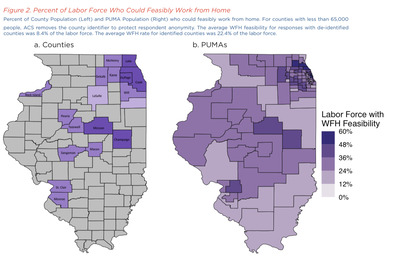* The University of Illinois System’s Institute of Government and Public Affairs…
A recent Policy Spotlight published by the University of Illinois System’s Institute of Government and Public Affairs titled “Working from Home in Illinois: Who Can and Does?” focuses on how Illinois workers adapted to working from home in the wake of the pandemic. Using the U.S. Census Bureau’s American Community Survey, researchers describe the nuanced trends, challenges and opportunities surrounding remote work in Illinois.
Concentrating on this robust data set, researchers mapped out the geographic locations where the Illinois workforce is employed in occupations that can work remotely. By examining workforce trends driven by the loosening of COVID-19 pandemic restrictions, the report reveals a significant increase in remote work prevalence — especially in management, business, science and arts professions. The shift is more pronounced in higher-income brackets, but remote work is more prevalent across all income levels in 2021.
“McLean County, for example, has a large proportion of its workers in finance and insurance occupations. In contrast, Kankakee County has a larger proportion of workers in health care and manufacturing,” said David Merriman, a co-author of the Policy Spotlight and interim director of the Institute of Government and Public Affairs. “The types of occupations and industries present in a county contribute greatly to whether the county’s labor force could work from home.”
Researchers explore the factors influencing who can and did work from home, including occupation types, geographic locations, gender and household dynamics, and access to high-speed internet. Focusing on gender and household dynamics, it appears that women with children were slightly more likely to work from home than women without children, but by 2021, men were still more likely to work from home regardless of whether they had young children. Additionally, the researchers highlight the importance of high-speed broadband infrastructure to facilitate remote work.
“Women under the age of 40 with children under five were slightly more likely to work from home compared with women without children under the age of five in both 2019 and 2021,” said Alea Wilbur-Mujtaba, a co-author of the Policy Spotlight and a Ph.D. student in public policy, management, and analytics at the University of Illinois Chicago.
Additionally, the researchers highlight the importance of high-speed broadband infrastructure to facilitate remote work
The report concludes that remote work is ingrained in Illinois’ workforce, mirroring national trends. It emphasizes the need for a comprehensive and equitable approach by policymakers, employers and society to address the lasting implications of remote work on state finances, economic disparities and work-life balance.
* From the report…
[Work from home] workers represent 13% of the Illinois work-force compared to 2.8% in 2019. In 2021, those in sales and office jobs represent close to 20% of the Illinois workforce, with 4% who are WFH.
* I found this figure interesting…

* Daily Yonder…
Last year, five Illinois counties took part in the Benton Institute’s Broadband Breakthrough program. The effort coached local leaders on how broadband expansion happens, how to conduct community surveys, and how to get a better shot at these incoming federal dollars.
In interviews with the Daily Yonder, participants said the program helped ready the counties for a “once-in-a-generation” funding opportunity, one that could help business owners like Braffet. […]
In Hancock County, at least two internet service providers have already applied for and will continue to apply for broadband expansion grants as the federal dollars become available, said Samantha Harnack, executive director of Hancock County Economic Development. […]
“The state is 100% not going to give anyone a grant that doesn’t have their ducks in a row,” Harnack said. “The federal government, same thing.”
It’s unclear just how long it will take to expand broadband access to underserved rural areas. Patricia Nordman, a district representative for the Ogle County government, said she’s thinking on a 10-year timescale.
* AP…
The White House is pressing Congress to extend a subsidy program that helps one in six U.S. families afford internet and represents a key element of President Joe Biden’s promise to deliver reliable broadband service to every American household. […]
The Affordable Connectivity Program offers qualifying families discounts on their internet bills — $30 a month for most families and up to $75 a month for families on tribal lands. The one-time infusion of $14.2 billion for the program through the bipartisan infrastructure law is projected to run out of money at the end of April. […]
[T]he program serves nearly an equal number of households in Republican and Democratic congressional districts, according to an AP analysis.
Biden has likened his promise of affordable internet for all American households to the New Deal-era effort to provide electricity to much of rural America. Congress approved $65 billion for several broadband-related investments, including the ACP, in 2021 as part of a bipartisan infrastructure law. He traveled to North Carolina last month to tout its potential benefits, especially in wide swaths of the country that currently lack access to reliable, affordable internet service/
Beyond the immediate impact to enrolled families, the expiration of the ACP could have a ripple effect on the impact of other federal broadband investments and could erode trust between consumers and their internet providers.
A bipartisan group of lawmakers recently proposed a bill to sustain the ACP through the end of 2024 with an additional $7 billion in funding — a billion more than Biden asked Congress to appropriate for the program at the end of last year. However, no votes have been scheduled to move the bill forward, and it’s unclear if the program will be prioritized in a divided Congress.
* More…
* WaPo | Millions to lose affordable internet unless Congress extends subsidies: The Affordable Connectivity Program took aim at closing the digital divide. But without a $6 billion infusion from Congress, the FCC will begin winding down the program this week.
* PBS | New tool gauges economic effects of expanded broadband in rural IL: A report by the Benton Institute for Broadband & Society estimates that, across 15 agricultural counties in Illinois, faster internet speeds could boost production of corn and soybeans by over $100 million annually.
* CNBC | Bosses want to work from home more than employees do, says new survey—but they’re still pushing RTO requirements: The survey found that 68% of bosses, a group that includes middle managers, executives and business owners, would like remote work to continue in 2024, while less than half (48%) of employees feel the same.
* USA Today | 2023 was the year return-to-office died. Experts share remote-work trends expected in 2024: Though a number of companies issued return-to-work mandates this year, most are allowing employees to work from home at least part of the week. That makes 2024 the year for employers to figure out the hybrid model.
* COStar | After Championing Remote Work, Dell Calls Employees Back to the Office: The Round Rock, Texas-based company told some of its employees that they must show up to a corporate hub at least 39 days a quarter, a mandate that shakes out to roughly three days a week, a Dell spokesperson confirmed to CoStar News. The new in-person requirement will apply to workers who have been operating on a hybrid policy, which the computer hardware company has gradually revised over the past couple of years.















- Give Us Barabbas - Tuesday, Feb 6, 24 @ 1:36 pm:
I found out the wrong things when I had to WFH remotely: I was faster and better and more productive at doing my job from my home, away from my boss. Clients were happier too.
- Anon221 - Tuesday, Feb 6, 24 @ 1:38 pm:
Still waiting for broadband in my rural area. I work from home and have done so since the pandemic relying on hotspots with 4G interconnectivty.
https://dewittdailynews.com/local-news/727479/broadband-map-challenge?utm_source=dlvr.it&utm_medium=facebook
https://beadchallenge.org/
More info on current status can be found on this map page. Some layers won’t show up unless you are zoomed in enough to activate them. Map site- https://gis.connectednation.org/portal/apps/webappviewer/index.html?id=caedfe7ce8924660a4ce62de6a75a7fd
More info- https://dceo.illinois.gov/connectillinois/mapping-review.html
- ArchPundit - Tuesday, Feb 6, 24 @ 1:47 pm:
Having decent broadband can be important in filling positions such as doctors or other needed professionals in rural areas as often their spouse can work from home with decent broadband. It also then can create some opportunities for new businesses as those spouses may start to create new businesses in the area.
- Timmy - Tuesday, Feb 6, 24 @ 3:37 pm:
Politicians are going to have to start standing up to multi-billion dollar companies like Xfinity and ATT. Scary for them. But some aren’t scared
- Former Downstater - Tuesday, Feb 6, 24 @ 4:12 pm:
This seems like one of the issues Bailey and Boss should be talking about.
- Give Us Barabbas - Tuesday, Feb 6, 24 @ 5:58 pm:
Municipal broadband fiber needs to be a thing, everywhere. Like the other utilities. It’s the only
way to put competitive pressure on monopoly providers. Which is why they spent so much money lobbying your legislators to not allow it.